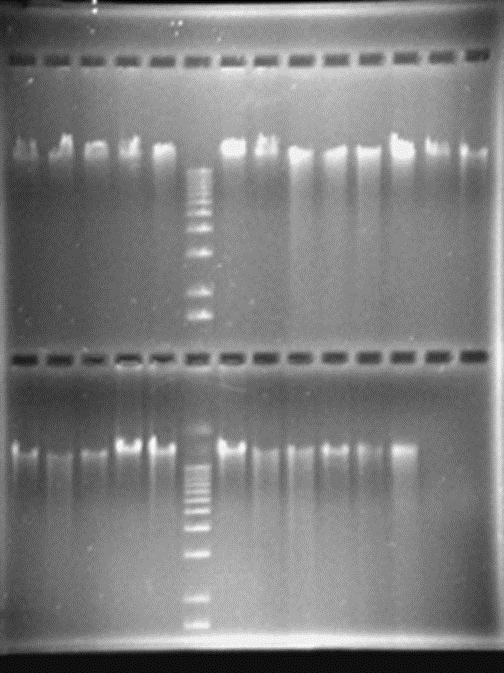You will be obtaining DNA from a tiny piece of tissue (about 25 mg), either fin, heart, or liver. Obviously taking tissue from fin is preferable since it does no harm to the fish. When other tissues are used, they are obtained from fisheries scientists who have used it for other experiments. For tissue sources see Equipment, Sources, and Timeline.
You will be using a kit to obtain the DNA from the tissue. Since DNA in your cells is intimately associated with many proteins, we will be using the enzyme called Proteinase K to digest away the protein.
Protocol for DNA Extraction using Qiagen kit
1) Obtain a tube with a piece of fin tissue. The fin tissue is normally stored in ethanol. Using forceps take the fin tissue out of the original tube, rinse with a little distilled water and put in a new 1.7 ml Eppendorf tube. Write the fish ID number on the tube (and in your notebook).
2) Add 180 ul ATL buffer to each tube containing rinsed fin tissue. (Check ATL for undissolved white crystals- if found, warm in hands for a couple minutes).
3) Add 20 ul of Proteinase K stock solution, mix by flicking the tube (or use vortex if available), and incubate at 50 - 55oC for 3 hours to overnight until the tissue disappears completely or mostly dissolved (lysed). Mix occasionally during incubation to disperse the sample, or place in a shaking water bath.
4) Add 200 ul of Buffer AL to the sample, mix thoroughly and incubate at 70 o C for 10 minutes (rinse hands afterwards- AL is a little caustic).
5) Add 200 ul of ethanol (95 – 100%) to the sample, and mix thoroughly.
6) Label the cap of a QIAamp spin column with fish ID number. (Note: collection tube that column is in need not be labeled. Query: Why not?). Carefully pour the mixture from step 5 (including any precipitate if there is any) to the spin column without moistening the rim, close the cap and centrifuge at at least 10,000 rpm (8,000 x g) for 1 minute (full speed is fine too).
7) Take the spin column out of the collection tube, pour the liquid out of the collection tube into the sink, and put the spin column back in the tube.
8) Carefully open the spin column and add 500 ul of Buffer AW1. Centrifuge at 10,000 rpm for 1 minute. Again, carefully remove the spin column from the collection tube, pour the liquid out of the collection tube, and place the spin column back in the now empty collection tube.
9) Carefully open the spin column and add 500 ul of Buffer AW2. Centrifuge at full speed (14,000 rpm) for 2 minutes (to dry the column material and make sure that residual ethanol does not does not contaminate the product in the final step).
10) Place the spin column in a clean eppendorf (labeled with fish ID number) and discard the collection tube containing the filtrate.
11) Carefully open the spin column. Elute the DNA into your labeled eppendorf tube, by adding 200 ul of Buffer AE to the spin column. Let tube sit at room temperature for 1 minute then centrifuge at 8,000 rpm for 1 minute.
The liquid you have collected contains the DNA. DO NOT THROW THIS TUBE AWAY – even after you have finished the whole lab project. Your teacher may want to archive your DNA to use in later years to look at different loci.
Agarose Gel: Visualize your total DNA on a 1% agarose gel (1 g agarose in 100 ml TBE or TAE buffer). Run 10 ul of your sample (with 1 ul loading dye). Also, remember to run a size standard (also known as ladder). Your teacher will provide you with the ladder. Depending on which ladder you use you will probably load 2 - 3 ul of the ladder with 1 ul of the loading dye. You should have plenty of DNA for genotyping, cloning or sequencing, or whatever you want to do with it. If you are using a loading dye that has two blue stains (methylene blue and cyanol) you should run the gel until the two blue bands divide the gel into thirds (usually about 30 min. at 100V). After running the gel, it will need to be stained to see the bands. Depending on the stain used, gels are stained anywhere from 30 minutes (for ethidium bromide) to overnight, and are then washed before visualizing on a light box. Your teacher will let you know the stain to be used and the staining procedure.
